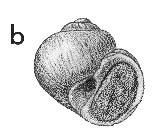
Revised descriptions of New Zealand Cenozoic Mollusca from Beu and Maxwell (1990)

 | Revised descriptions of New Zealand Cenozoic Mollusca from Beu and Maxwell (1990) | 
|
  (Pl. 8b): GS11200, J40/f8853, Kapua Tuff, Waihao River, Kaiatan (GNS) |
Beu & Maxwell (1990): Chapter 8; p. 119; pl. 8 b.
Synonymy: Natica (Carinacca) haasti Marwick 1924d, p. 554; Friginatica haasti; Sulconacca haasti; "Uberella" haasti, Beu & Maxwell 1990, p. 119
Type species of Tahunacca Maxwell, 1992 [p. 104]
Classification: Naticidae: Poliniceinae
Description: Size moderate for family (height 7-13 mm), globose, spire 0.2-0.3 total height. Apex corroded in all known specimens, protoconch probably paucispiral and incompletely calcified. Teleoconch whorls turned in towards suture adapically, forming a narrow sutural shelf that becomes depressed below the rounded shoulder on later whorls. Sutures deeply impressed rather than channelled. Last whorl strongly convex, with a moderately wide umbilicus bordered by a heavy ridge that is somewhat concave in young shells but gently convex in adults. Outer edge of circumbilical ridge sharply defined and steep in young shells, more rounded in adults; inner edge rounded. Sculpture of weak growth lines and fine spiral threads. Aperture semilunular; inner lip almost straight, thickened abapically where circumumbilical ridge impinges. Parietal callus moderately thick, narrowing quickly below. Outer lip inclined at about 30° to vertical, straight except where it is feebly retracted to suture.
Comparison: This distinctive naticid seems to combine characters of both Carinacca and Friginatica, but the similarities are mostly superficial, and the new genus Tahunacca was established for it by Maxwell (1992, p. 104). The circumumbilical ridge is rather like that of species of Carinacca, but is less rounded in section and lacks the steep step on the inner edge. T. haasti also differs from species of Carinacca in having what was probably a paucispiral, incompletely calcified protoconch and in having deeply impressed rather than adpressed sutures. Friginatica suturalis seems to have had a similar kind of protoconch to T. haasti, but its teleoconch differs in having sharply channelled rather than deeply impressed sutures, and a sulcus rather than a ridge bordering the umbilicus. T. haasti previously has been referred to Uberella, but the type species, U. vitrea (Castlecliffian — Recent, New Zealand) is ovate rather than globose, has adpressed sutures, evenly convex teleoconch whorls and a narrow umbilicus, lacks spiral sculpture and an umbilical ridge, and does not have the base of the inner lip thickened. T. haasti seems to be most closely related to T. acerva (Otaian, Bluecliffs, South Canterbury; included in Tahunacca by Maxwell 1992, p. 104), differing mainly in having a prominent ridge rather than a faint swelling bordering the umbilicus. Both species seem to have been confined to moderately deep waters (i.e. outer shelf or upper slope depth).
Distribution: Bortonian-Kaiatan; Waihao Greensand, McCulloch's Bridge, Kaiatan (type); Kapua Tuff, Waihao River; Hampden Formation, Hampden Beach; Point Elizabeth Beach, Westland. Moderately common at McCulloch's Bridge, uncommon at other localities.
Cite this publication as: "A.G. Beu and J.I. Raine (2009). Revised
descriptions of New Zealand Cenozoic Mollusca from Beu and Maxwell (1990). GNS
Science miscellaneous series no. 27."
© GNS Science, 2009
ISBN
978-0-478-19705-1
ISSN 1177-2441
(Included with a PDF facsimile file
copy of New Zealand Geological Survey Paleontological Bulletin 58 in CD version
from: Publications Officer, GNS Science, P.O. Box 30368 Lower Hutt, New
Zealand)